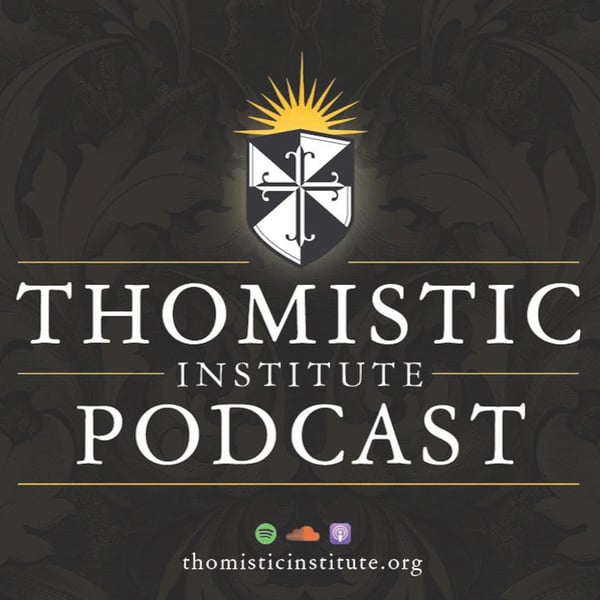Fertile Ground in Our Cosmic Backyard | Prof. Jonathan Lunine
The Thomistic Institute
The Thomistic Institute
4.8 • 729 Ratings
🗓️ 28 November 2022
⏱️ 59 minutes
🧾️ Download transcript
Summary
Prof. Lunine's slides may be viewed here: https://tinyurl.com/22vs3mdv This lecture was given on October 14, 2022, at the Dominican House of Studies in Washington, D.C., as part of the Thomistic Circles conference entitled, "Life in the Cosmos: Contemporary Science, Philosophy, and Theology on the Origin and Persistence of Life on Earth (and Beyond?)." For more information on upcoming events, please visit our website at thomisticinstitute.org. About the speaker: Jonathan I. Lunine is The David C. Duncan Professor in the Physical Sciences at Cornell University and Director of the Cornell Center for Astrophysics and Planetary Science, His research focuses on astrophysics, planetary science and astrobiology. In addition to his responsibilities in the classroom, he serves as Interdisciplinary Scientist on the James Webb Space Telescope project and is a coinvestigator on the Juno mission currently in orbit around Jupiter. Lunine is a member of the U.S. National Academy of Sciences, a fellow of the American Geophysical Union and the American Association for the Advancement of Science. He is the 2014 recipient of the Jean Dominique Cassini Medal of the European Geosciences Union. He is the author of Astrobiology: A Multidisciplinary Approach and Earth: Evolution of a Habitable World. Lunine obtained a B.S. in physics and astronomy from the University of Rochester (1980), an M.S. (1983) and a Ph.D. (1985) in planetary science from the California Institute of Technology. He lives in Ithaca New York, where he is a member of St. Catherine of Siena parish. In 2016 Lunine helped to found the Society of Catholic Scientists. About the conference: What is life? How did biological life arise? What makes life persist and might it exist elsewhere in the cosmos? What would that mean? Consider these questions and more with the Thomistic Institute at the Fall Thomistic Circles conference, Life in the Cosmos: Contemporary Science, Philosophy, and Theology on the Origin and Persistence of Life on Earth (and Beyond?). The two-day conference at the Dominican House of Studies in Washington, D.C. features a stellar, cross-disciplinary lineup of speakers, scientists Jonathan Lunine (Cornell University) and Maureen Condic (University of Utah), philosopher Christopher Frey (University of South Carolina), and theologian Fr. Mauriusz Tabaczek, O.P. (Angelicum). This conference is part of the Thomistic Institute’s Scientia Project.
Transcript
Click on a timestamp to play from that location
| 0:00.0 | This talk is brought to you by the Tamistic Institute. |
| 0:03.8 | For more talks like this, visit us at tamistic institute.org. |
| 0:11.3 | So I'm going to talk today about how to look for life elsewhere in the solar system. |
| 0:17.0 | And I want to motivate why this is an interesting question and why we would want to look |
| 0:22.3 | in our solar system as opposed to in the galaxy beyond. So I'm going to start by asking the question |
| 0:32.7 | and not answering it as to whether the origin of life and the potential prevalence of life is something that's baked into the nature of the cosmos. |
| 0:43.3 | So if you look at the evolution of the cosmos in a very, very broad brush way, it really divides into three things. The middle thing here, which is galaxy, stars, and |
| 0:57.1 | planets is astronomy as its practice today. Galaxies or clusters of galaxies are essentially |
| 1:05.5 | the fundamental unit of structure in our universe today. They're held together, not by normal luminous matter, |
| 1:13.7 | but actually by dark matter, which is not well understood, but is most of the matter in the cosmos. |
| 1:19.9 | The content of the galaxies themselves is gas and dust and stars. And as has been learned in the last 20 years, on average, in our galaxy, |
| 1:32.1 | at least, for every star there's a planet. So planets are as abundant as stars in the universe. |
| 1:38.6 | So whatever process forms stars goes on to form planets as well. So there's an evolutionary process there, but it has to |
| 1:46.6 | begin with the development of structure. And the development of structure in the universe begins |
| 1:52.8 | in the upper part of this figure with essentially three constructs or events. |
| 2:01.0 | One is the Big Bang, which is essentially the beginning of the expansion of the universe, |
| 2:09.6 | and actually the beginning of the universe's matter and energy as we understand them. |
| 2:15.1 | And then there are two other things up there that are not quite as well understood |
| 2:19.5 | and actually are rather speculative. Now, the Big Bang itself is a fairly well-accepted concept |
| 2:28.5 | that the universe, as we know, space is expanding. In fact, it's accelerating. And so a finite period of time ago, |
| 2:37.4 | all of the matter and energy in the universe |
| 2:39.5 | was in a very, very different state, |
... |
Please login to see the full transcript.
Disclaimer: The podcast and artwork embedded on this page are from The Thomistic Institute, and are the property of its owner and not affiliated with or endorsed by Tapesearch.
Generated transcripts are the property of The Thomistic Institute and are distributed freely under the Fair Use doctrine. Transcripts generated by Tapesearch are not guaranteed to be accurate.
Copyright © Tapesearch 2025.

